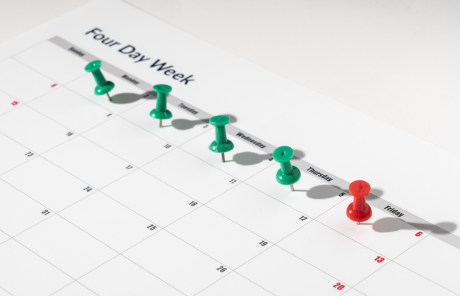
The 4-Day Work Week: Is It Worth The Hype?
- Posted by Joel Okoye
- April 28, 2023
The concept of having a shorter workweek isn’t a new one by any means. Industries have long since recognised the benefits it can provide for employees and their business, with the (then-revolutionary) idea of a 5 day work week first being
Until recently that is.
On Trial – The 4-day Week
The idea of a 4-day, or 32-hour work week had begun to garner mainstream attention in the last few years, with six countries (Canada, Australia, Ireland, the UK, New Zealand and the US), already experimenting with it over the past year. In June 2022 we saw the introduction of the first UK 4-day workweek trial, (piloted by organisations 4-Day Week Global and Autonomy) in which 61 companies and 2,900 workers participated, which sought to achieve the same results as the current working week structure and find a better common ground between employers and employees..
And with the results of the trial having been published in February 2023, we now have a glimpse into how it could work across a variety of sectors in what has been heralded by and large as a resounding success.
One of the biggest selling points of the 4-day week notion to employers is the increase in productivity that workers experience. Contrary to how counter intuitive it can appear at first, research from a study conducted by the University of Auckland has shown that a shorter workweek can give rise to greater levels of productivity from employees compared to a standard 5-day workweek. The study involved a New Zealand company, Perpetual Guardian, which trialled a four-day workweek for two months and during the trial, employees reported feeling less stressed and more focused, which led to an increase in their productivity levels.
Similarly, in the pilot, many employees reported improved work-life balance, reduced stress levels, and better overall well-being, with 60% of workers finding it easier to combine their work with caring responsibilities and 62% better able to juggle work with their social life. And it’s showing very encouraging signs business-wise as well, as key metrics show that companies’ revenue, by and large, hadn’t changed over the trial period, but instead showed a healthy increase (35% on average) compared to data from similar reports in previous years. The number of resignations in participating companies also saw a significant decline (57%), highlighting the true value of the benefits that the 4-day workweek structure provided to employees.
The most persuasive statistic of all when considering the longevity and permanency of such a working arrangement is that 92% of companies (56) that participated decided to continue with the model, (with 18 of them making it permanent). It certainly seems to offer a new perspective for employers and employees to find common ground when attempting to strike that delicate balance between increasing productivity & sales whilst also creating a more supportive work environment.
Research Associate at University of Cambridge, Dr. David Frayne, attested to its effectiveness:
“We feel really encouraged by the results, which showed the many ways companies were turning the four-day week from a dream into a realistic policy, with multiple benefits. We think there is a lot here that ought to motivate other companies and industries to give it a try”.
What Still Remains Unanswered?
But which questions do the results still not answer? And what are the implications for the working world at large should this become a new reality?
Perhaps the first thing that springs to mind when looking at all the positive discourse regarding the results of the trial is, ‘’can it deliver on the promise it’s showing?’’ While it’s certainly no pipedream to believe it can, considering the trial’s outstanding results, it does highlight a need for a touch of pragmatism when assessing the 4-day workweek’s feasibility and in particular for sectors where it has proven difficult to implement or has just not been successful when doing so.
Take customer-facing businesses for example.
Unlike other professional services that often involve project-type work (which gives employees a greater degree of flexibility when it comes to deadlines), companies in this line of work must have a certain number of staff on-site to take care of the more hands-on aspects of the role and ensure a smooth running of the business.
Naturally, there are bound to be scheduling challenges that arise because of this when implementing the model as customer needs must still be managed effectively, and the business must ensure that communication between teams and with customers is maintained at all times, meaning the idea of a three-day weekend every week for some companies is just not feasible. Certain sectors such as education, healthcare or public transport may argue that this is just not feasible at all.
And even if staffing and logistics issues could be overcome within these sectors, not all can guarantee a productivity increase (and money on the bottom line) to make up for the reduced hours of a 32-hour workweek particularly as such businesses or public services will have to take on extra staff to cover any shortfalls, meaning extra costs overall.
One such company that ran into several of these practical issues when implementing it across their business is Engineering and Industrial supplies company Allcap. Despite reducing the frequency of their staff’s three-day weekend to once every fortnight (due to the nature of their business), they found adapting to the 4-day workweek model difficult, particularly with the increase in daily workload. Employees found it difficult to benefit from the extra day of rest that they had available, as their new week structure now meant that they had gone from ‘’10 normal working days to 9 intense ones’’, making them exhausted by the end of their week. Added to this was the difficulty in finding enough staff to cover for the absences of employees on their free day when holidays, sickness and caring responsibilities were all factored in. Ultimately, and with two months of the trial still planned in, Allcap was forced to abandon across its main trade sites.
Mass Rollout Or Mass Walkout?
As seen from numerous other examples in the trial results, it is certainly not a one-size-fits-all approach and not all businesses can afford the wiggle room needed to adapt to it, which raises valid concerns about its applicability on a larger scale.
Its scalability isn’t the only question mark about it either, as there is the concern of how sustainable it can be over longer periods of time than just the 6 months, considering the unknown long-term impact of a 4-day workweek’s intense work pattern on the physical and mental well-being of employees.
Could the exact reasons for pushing ahead with the pilot around staff wellbeing lead to a worsened state in the long run? It does very much depend on the sector, the type of work being conducted, and the expectations of the customer base – and on that basis it is harder to see how this could be rolled out en masse irrespective of these nuances.
So what next for the trial? And where does all this leave us with regards to the current state of affairs?
Post pandemic, it is clear that there is a growing focus on greater flexibility from employees who are more mindful of when, where, and how they work. In turn, there has been much narrative from businesses around hybrid, flexi, remote-working and analysis of these changes on the impact of business performance and productivity.
Undoubtedly, there has already been a seismic shift in working patterns as numerous companies move to more flexible means of working but is a further shift to a shorter week on top of this a step too far – at the moment at least?
“Even as the value of the pound goes up and down, the value of people’s time doesn’t.”
Summed up nicely by the above quote from Programme Manager Alex Soojung-Kim Pang at 4 Day Week Global, perhaps the biggest litmus test for the 4-day model, and currently its biggest barrier to a much-anticipated systematic change, is how well it can fare in not just the current economic climate, but an ever-changing one.
With vacancies harder to fill, and potentially more staff on the books (for some sectors) to accommodate a 4-day workweek, it simply isn’t an option at the moment for some, and whether it can still be as viable and as practical in unfavourable conditions remains to be seen.
One thing is for sure though, change won’t happen overnight.
About Clayton Recruitment
Clayton Recruitment has been partnering with organisations across the country since 1989 and during that time has built up an excellent reputation for trust and reliability.
With specialist divisions covering Commercial, Financial, and Engineering appointments, on a permanent basis.
If you are building your existing team or looking for your next career move, we can help. And, if you are currently employed, you can be assured of complete confidentiality, professionalism, and honesty throughout the process – as standard.
Click here to speak to one of our experienced specialists or call 01772 259121 for more information on how our exceptional recruitment experience can help your career aspirations.





